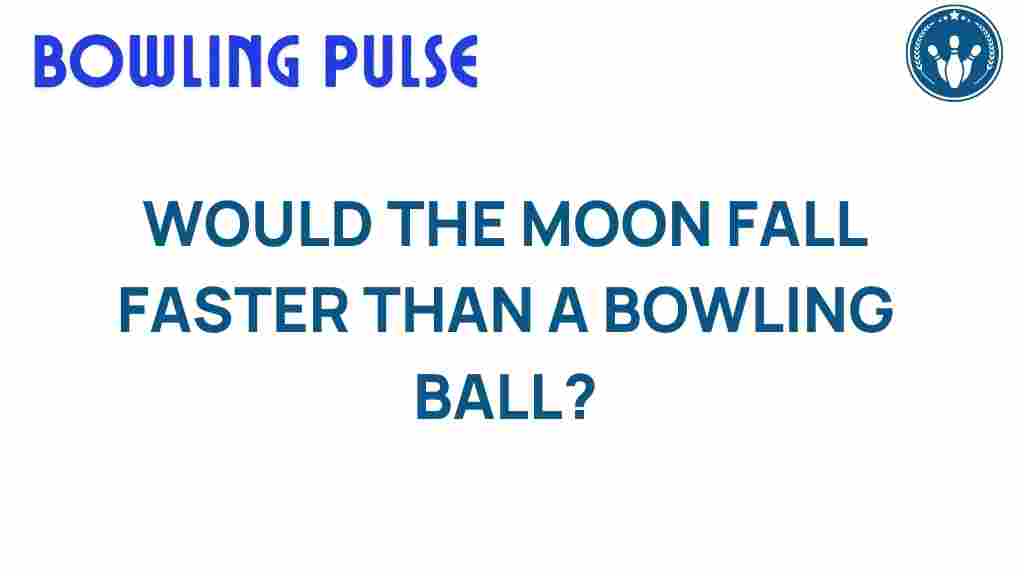The Gravitational Showdown: Would the Moon Fall Faster Than a Bowling Ball?
When we think about gravity, we often imagine how it affects objects around us on Earth. But have you ever wondered how gravity would act on larger celestial bodies, like the Moon? In this article, we will explore the fascinating concept of free fall, the speed and acceleration of different objects, and whether a bowling ball would fall faster than the Moon. This scientific experiment will take us through the principles of physics that govern these phenomena, ultimately leading to an exciting conclusion.
Understanding Gravity
Gravity is a fundamental force of nature that attracts two bodies towards each other. It is responsible for keeping us grounded on Earth, influencing the motion of planets, and even governing the behavior of galaxies. The strength of gravity depends on two factors: the mass of the objects and the distance between them. The formula for gravitational force is expressed as:
F = G * (m1 * m2) / r²
Where:
- F = gravitational force
- G = gravitational constant
- m1 = mass of the first object
- m2 = mass of the second object
- r = distance between the centers of the two masses
Free Fall: The Basic Concept
Free fall occurs when the only force acting on an object is gravity. In this state, all objects, regardless of their mass or composition, will accelerate towards the Earth (or other celestial bodies) at the same rate. This acceleration due to gravity on Earth is approximately 9.81 m/s². But how does this apply to our gravitational showdown between the Moon and a bowling ball?
The Physics Behind Our Experiment
To determine whether the Moon would fall faster than a bowling ball, we need to consider several key principles of physics:
- Mass and Acceleration: According to Newton’s Second Law of Motion, the force acting on an object is equal to its mass multiplied by its acceleration (F = m * a). However, when in free fall, the mass of the object does not affect the rate of acceleration due to gravity.
- Terminal Velocity: When an object is falling through the atmosphere, it eventually reaches a point where the force of gravity is balanced by air resistance, resulting in a constant speed known as terminal velocity. This concept is crucial when comparing objects of different shapes and sizes.
- Relative Motion: The Moon and the bowling ball are both subject to gravitational forces, but their environments are vastly different. The Moon is in a vacuum, while the bowling ball experiences air resistance when dropped from a height.
Conducting the Experiment
To visually demonstrate the concepts of free fall and gravitational acceleration, we can conduct a simple experiment. Here’s how you can replicate this at home:
Materials Needed
- A bowling ball
- A feather (or a small piece of paper)
- A vacuum chamber (optional, but ideal for demonstrating free fall)
- A stopwatch
- A measuring tape
Step-by-Step Process
- Setup: If you have a vacuum chamber, place the bowling ball and feather inside. If not, you can simply drop them from the same height outside.
- Measure the Drop Height: Use the measuring tape to determine a drop height of at least 2 meters.
- Drop the Objects: Simultaneously release the bowling ball and feather (or piece of paper) from the measured height.
- Time the Fall: Use the stopwatch to measure how long it takes for each object to hit the ground.
- Observe the Results: Compare the time taken for the bowling ball and feather to fall. In a vacuum, they should hit the ground simultaneously.
What Did We Learn?
This experiment demonstrates that in the absence of air resistance, all objects fall at the same rate regardless of their mass. The bowling ball and feather fall together in a vacuum, highlighting the principle of free fall. However, when conducted outside, the feather experiences air resistance, causing it to fall slower than the bowling ball.
Common Troubleshooting Tips
If you’re conducting this experiment at home, you might face some challenges. Here are some troubleshooting tips:
- Inconsistent Drop Timing: Make sure to release both objects simultaneously to get accurate results.
- Wind or Air Current Effects: Conduct the experiment indoors or in a calm environment to minimize air resistance.
- Measuring Accuracy: Ensure that your measuring tape is straight and that you are measuring the height from the same point for both objects.
Conclusion
In conclusion, the gravitational showdown between the Moon and a bowling ball brings to light some fascinating aspects of physics. While the Moon, being a massive celestial body, may seem like it would fall faster due to its size, the truth is that in the realm of free fall, all objects accelerate at the same rate regardless of their mass, provided air resistance is not a factor.
The principles of gravity and free fall have profound implications not only in our understanding of the universe but also in practical applications. Whether it’s launching satellites into orbit or predicting the behavior of objects in motion, the science of gravity continues to play a pivotal role.
For more exciting science experiments and physics concepts, check out this resource that dives deeper into the wonders of the universe!
Remember, the next time you drop a bowling ball or gaze at the Moon, you’re witnessing the incredible forces of physics at work!
To learn more about the fascinating world of gravity and its effects on everyday objects, visit this informative site.
This article is in the category Culture and created by BowlingPulse Team
